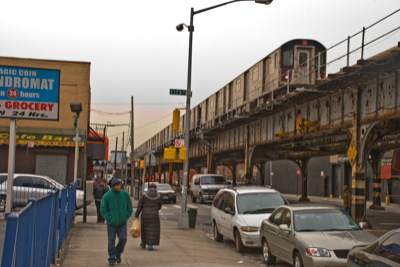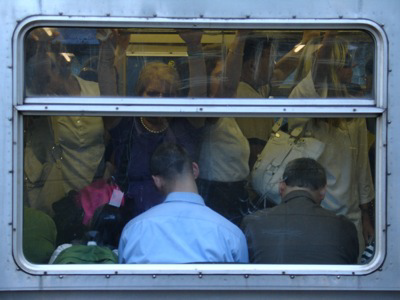No Light Rail in Vancouver!
A Model for the Nation: New York MTA’s Fiscal Crisis

How many times have you heard someone say, “If only our city had a transit system like New York City’s. Then lots of people would ride transit!” Everyone seems to take it for granted that New York’s subway system is wonderful. Even the Antiplanner’s faithful ally, Wendell Cox, includes the New York subway among his short list of “urban rail success stories.”

Modern transportation.
Flickr photo by PhillipC.
But there is trouble in Gotham City, and not the kind that can be solved by a batman (unless he is a very, very rich batman). In technical terms, the Metropolitan Transportation Authority (MTA) “is in deep doo doo.” In financial terms, the MTA needs to find $30 billion to rehabilitate its subways over the next five years — and is somewhere around $17 billion short. That’s about $2,000 per New York City resident. Not even Bruce Wayne would be willing to donate $17 billion to the Gotham subway system — especially when it would probably demand another $17 billion or so just a few years later.
Take a quick look at the numbers: In 2006, MTA subways carried about 8.4 billion
passenger miles. Fares covered two-
This raises one of the Antiplanner’s pet peeves, that of calling the replacement
of worn-
Because of the maintenance, er, capital shortfalls, New York subway riders are suffering from increasing breakdowns. Ironically, a recent city report that rated the L train as the least delayed overall was published just a few weeks after the New York Observer described the L train as “bringing New Yorkers together, one service disruption at a time.”
To deal with gas-

Comfortable commute.
Flickr photo by DominicVine.
According to a New York Daily News editorial, it is somehow unfair to ask subway riders to pay their own way (or even 40 percent of their own way). The “fare plan” (get it? fare = fair), says the paper, is for the state of New York to “rescue” MTA with increased subsidies.
According to a New York Daily News columnist Michael Daly, this is appropriate because MTA’s problems stem from state budget cuts in 1995 that reduced state subsidies and forced MTA to finance improvements by issuing $10 billion in new bonds. According to MTA’s budget, those bonds along with existing debt means that MTA is spending $1.6 billion this year in debt service alone — an amount that is expected to grow to $1.9 billion by 2010 (see physical page 62). New York Governor David Paterson has appointed a commission to find some solutions to MTA’s problems.
But MTA’s real problem is that transit agencies and supporters feel they are entitled to huge subsidies at everyone else’s expense. Daly, for example, complains that the federal government is neglecting its obligation to the subway system. Why should the feds give $36 billion to corn farmers to make ethanol, he asks, and not give one red cent to operate the subway system? Of course, Congress did give MTA a whopping $1 billion for capital improvements (as the transit industry defines them) in 2006.
Daly’s reasoning is the kind of thinking that led to a $10 trillion federal debt; as in, “somebody over there is subsidized, so why don’t you subsidize me!” Or, as an advocate of turning Lawrence Welk’s childhood home into a national park once put it, “If there is money to be wasted, it might as well be wasted here.” The right answer to Daly’s question is that the feds shouldn’t give $36 billion to corn farmers any more than it should give billions to New York City transit riders.
New York’s Mayor Bloomberg’s solution for MTA was a so-
According to Wendell Cox, the only rail transit operations in the world that pay their own way are in Hong Kong and Tokyo. By Cox’s calculations, the Tokyo urban area is about three times as dense as the New York urban area, while Hong Kong is 15 times as dense. Maybe rail only makes sense at such high densities.
Why should paying its way be the test for a transit system’s success? Partly because a system that can’t pay its way ends up suffering repeated financial crises, breakdowns, and imposing other indignities (seatless subways?) on passengers.
Beyond that, there is the whole question of sustainability, which is (or ought to
be) an economic issue as well as an ecological one. If the U.S. looks unsustainable
today, it is as much due to our huge deficits — imposing ever-
So the next time you hear someone laud the New York transit system, ask them if they mean the system that is running a $1.9 billion operating deficit (including bus operations)? Or the one whose 2008 revenues (including all subsidies) are expected to be $900 million less than costs? Or the one that is perpetually in some financial crisis or another? No matter which one you pick, MTA is just one more reminder that rail transit is really, really expensive.
Trackback • Posted in Transportation
Reprinted from The Antiplanner